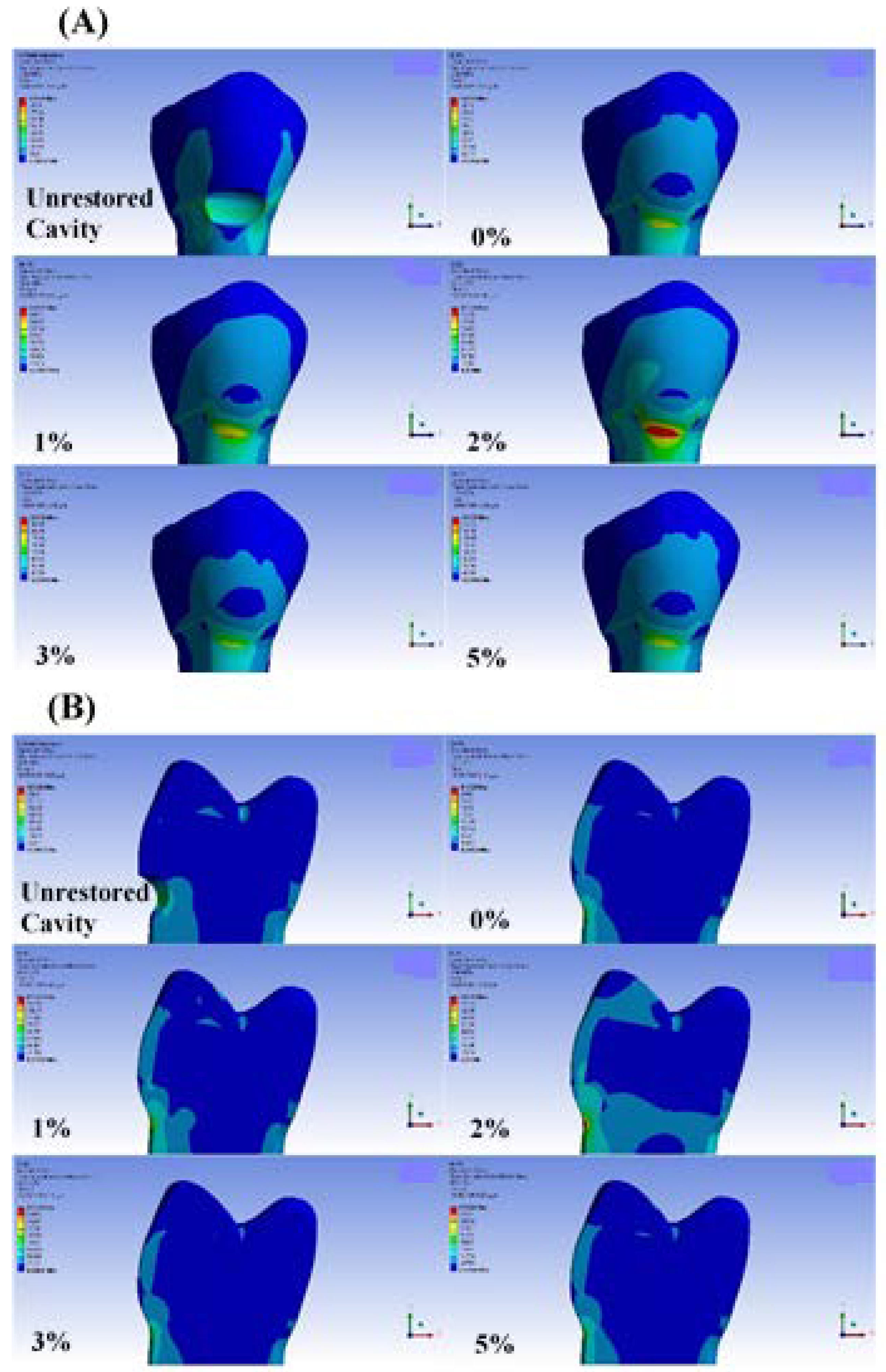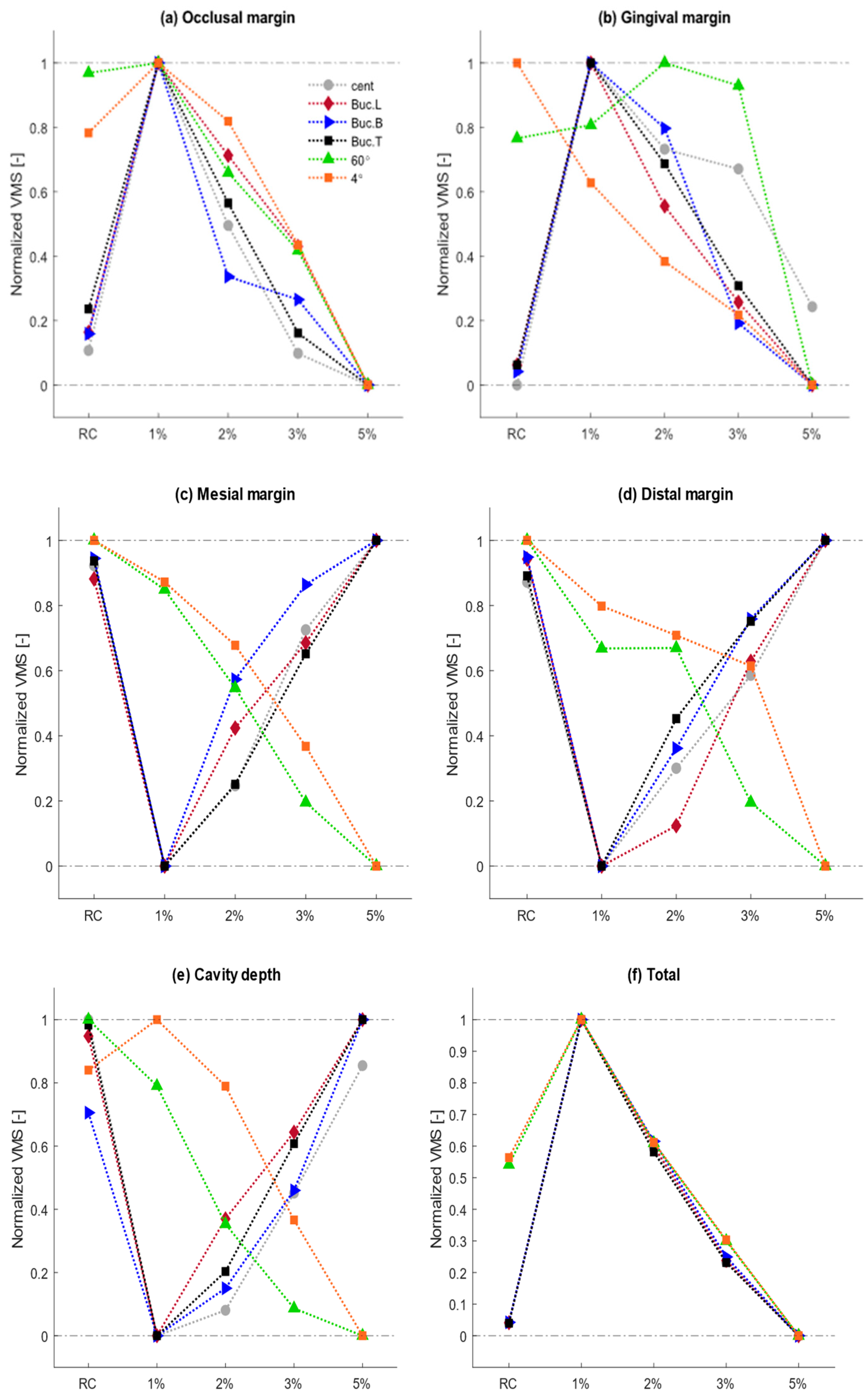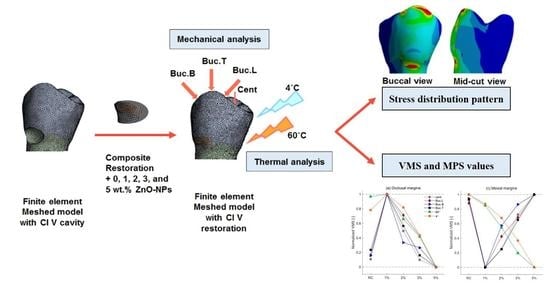Mechanical and Thermal Stress Analysis of Cervical Resin Composite Restorations Containing Different Ratios of Zinc Oxide Nanoparticles: A 3D Finite Element Study
Abstract
:1. Introduction
2. Materials and Methods
3. Results
3.1. Von Mises Stress Analysis
3.1.1. Mechanical Stress Analysis
3.1.2. Thermal Stress Analysis
3.1.3. Temperature Assessment
3.2. Maximum Principal Stress Analysis
3.2.1. Mechanical Stress Analysis
3.2.2. Thermal Stress Analysis
4. Discussion
5. Conclusions
Supplementary Materials
Author Contributions
Funding
Institutional Review Board Statement
Informed Consent Statement
Data Availability Statement
Conflicts of Interest
References
- Gil-Montoya, J.A.; Ferreira de Mello, A.L.; Barrios, R.; Gonzalez-Moles, M.A.; Bravo, M. Oral health in the elderly patient and its impact on general well-being: A nonsystematic review. Clin. Interv. Aging 2015, 10, 461–467. [Google Scholar] [CrossRef] [PubMed] [Green Version]
- Tonetti, M.S.; Bottenberg, P.; Conrads, G.; Eickholz, P.; Heasman, P.; Huysmans, M.C.; Lopez, R.; Madianos, P.; Müller, F.; Needleman, I.; et al. Dental caries and periodontal diseases in the ageing population: Call to action to protect and enhance oral health and well-being as an essential component of healthy ageing—Consensus report of group 4 of the joint EFP/ORCA workshop on the boundaries between caries and periodontal diseases. J. Clin. Periodontol. 2017, 44, S135–S144. [Google Scholar] [PubMed] [Green Version]
- López, R.; Smith, P.C.; Göstemeyer, G.; Schwendicke, F. Ageing, dental caries and periodontal diseases. J. Clin. Periodontol. 2017, 44, S145–S152. [Google Scholar] [CrossRef] [Green Version]
- Yang, J.; Cai, D.; Wang, F.; He, D.; Ma, L.; Jin, Y.; Que, K. Non-carious cervical lesions (NCCL s) in a random sampling community population and the association of NCCL s with occlusive wear. J. Oral Rehabil. 2016, 43, 960–966. [Google Scholar] [CrossRef]
- Ommerborn, M.A.; Schneider, C.; Giraki, M.; Schafer, R.; Singh, P.; Franz, M.; Raab, W.H. In vivo evaluation of noncarious cervical lesions in sleep bruxism subjects. J. Prosthet. Dent. 2007, 98, 150–158. [Google Scholar] [CrossRef]
- Senna, P.; Del Bel Cury, A.; Rösing, C. Non-carious cervical lesions and occlusion: A systematic review of clinical studies. J. Oral Rehabil. 2012, 39, 450–462. [Google Scholar] [CrossRef] [PubMed]
- Mjör, I.A.; Toffentti, F. Secondary caries: A literature review with case reports. Quintessence Int. 2000, 31, 165–179. [Google Scholar]
- Lee, W.C.; Eakle, W. Stress-induced cervical lesions: Review of advances in the past 10 years. J. Prosthet. Dent. 1996, 75, 487–494. [Google Scholar] [CrossRef]
- Sabbagh, J.; Fahd, J.C.; McConnell, R.J. Post-operative sensitivity and posterior composite resin restorations: A review. Dent. Updat. 2018, 45, 207–213. [Google Scholar] [CrossRef]
- Burke, F.J.T. Dental materials: What goes where? class V restorations. Dent. Updat. 2015, 42, 829–839. [Google Scholar] [CrossRef]
- Guler, M.S.; Guler, C.; Cakici, F.; Cakici, E.B.; Sen, S. Finite element analysis of thermal stress distribution in different restorative materials used in class V cavities. Niger. J. Clin. Pract. 2016, 19, 30–34. [Google Scholar] [PubMed]
- Shubhashini, N.; Meena, N.; Shetty, A.; Kumari, A.; Naveen, D.N. Finite element analysis of stress concentration in Class V restorations of four groups of restorative materials in mandibular premolar. J. Conserv. Dent. 2008, 11, 121–126. [Google Scholar]
- Stewardson, D.; Creanor, S.; Thornley, P.; Bigg, T.; Bromage, C.; Browne, A.; Cottam, D.; Dalby, D.; Gilmour, J.; Horton, J.; et al. The survival of Class V restorations in general dental practice: Part 3, five-year survival. Br. Dent. J. 2012, 212, E14. [Google Scholar] [CrossRef] [PubMed]
- Stewardson, D.A.; Thornley, P.; Bigg, T.; Bromage, C.; Browne, A.; Cottam, D.; Dalby, D.; Gilmour, J.; Horton, J.; Roberts, E.; et al. The survival of Class V restorations in general dental practice. Part 2, early failure. Br. Dent. J. 2011, 210, E19. [Google Scholar] [CrossRef]
- Franco, E.B.; Benetti, A.R.; Ishikiriama, S.K.; Santiago, S.L.; Lauris, J.; Jorge, M.F.F.; Navarro, M.F.L. 5-year Clinical Performance of Resin Composite Versus Resin Modified Glass Ionomer Restorative System in Non-carious Cervical Lesions. Oper. Dent. 2006, 31, 403–408. [Google Scholar] [CrossRef] [Green Version]
- Battancs, E.; Fráter, M.; Sáry, T.; Gál, E.; Braunitzer, G.; Szabó, P.B.; Garoushi, S. Fracture Behavior and Integrity of Different Direct Restorative Materials to Restore Noncarious Cervical Lesions. Polymers 2021, 13, 4170. [Google Scholar] [CrossRef]
- Bezerra, I.M.; Brito, A.C.M.; de Sousa, S.A.; Santiago, B.M.; Cavalcanti, Y.W.; de Almeida, L.D.F.D. Glass ionomer cements compared with composite resin in restoration of noncarious cervical lesions: A systematic review and meta-analysis. Heliyon 2020, 6, e03969. [Google Scholar] [CrossRef]
- Peumans, M.; Politano, G.; Van Meerbeek, B. Treatment of noncarious cervical lesions: When, why, and how. Int. J. Esthet. Dent. 2020, 15, 16–42. [Google Scholar]
- Song, W.; Ge, S. Application of Antimicrobial Nanoparticles in Dentistry. Molecules 2019, 24, 1033. [Google Scholar] [CrossRef] [Green Version]
- Priyadarsini, S.; Mukherjee, S.; Mishra, M. Nanoparticles used in dentistry: A review. J. Oral Biol. Craniofacial Res. 2018, 8, 58–67. [Google Scholar] [CrossRef] [Green Version]
- Pushpalatha, C.; Suresh, J.; Gayathri, V.; Sowmya, S.; Augustine, D.; Alamoudi, A.; Zidane, B.; Albar, N.H.M.; Patil, S. Zinc Oxide Nanoparticles: A Review on Its Applications in Dentistry. Front. Bioeng. Biotechnol. 2022, 10, 917990. [Google Scholar] [CrossRef]
- Nguyen, T.M.T.; Wang, P.W.; Hsu, H.M.; Cheng, F.Y.; Shieh, D.B.; Wong, T.Y.; Chang, H.J. Dental cement’s biological and mechanical properties improved by ZnO nanospheres. Mater. Sci. Eng. C 2019, 97, 116–123. [Google Scholar] [CrossRef]
- Almoudi, M.M.; Hussein, A.S.; Abu Hassan, M.I.; Zain, N. A systematic review on antibacterial activity of zinc against Streptococcus mutans. Saudi Dent. J. 2018, 30, 283–291. [Google Scholar] [CrossRef] [PubMed]
- Moradpoor, H.; Safaei, M.; Mozaffari, H.R.; Sharifi, R.; Imani, M.M.; Golshah, A.; Bashardoust, N. An overview of recent progress in dental applications of zinc oxide nanoparticles. RSC Adv. 2021, 11, 21189–21206. [Google Scholar] [CrossRef] [PubMed]
- Hojati, S.T.; Alaghemand, H.; Hamze, F.; Babaki, F.A.; Rajab-Nia, R.; Rezvani, M.B.; Kaviani, M.; Atai, M. Antibacterial, physical and mechanical properties of flowable resin composites containing zinc oxide nanoparticles. Dent. Mater. 2013, 29, 495–505. [Google Scholar] [CrossRef] [PubMed]
- Guerreiro-Tanomaru, J.M.; Trindade-Junior, A.; Costa, B.C.; Da Silva, G.F.; Cifali, L.D.; Bernardi, M.I.B.; Tanomaru-Filho, M. Effect of Zirconium Oxide and Zinc Oxide Nanoparticles on Physicochemical Properties and Antibiofilm Activity of a Calcium Silicate-Based Material. Sci. World J. 2014, 2014, 975213. [Google Scholar] [CrossRef] [Green Version]
- Vanajassun, P.P.; Nivedhitha, M.; Nishad, N.; Soman, D. Effects of zinc oxide nanoparticles in combination with conventional glass ionomer cement: In vitro study. Adv. Hum. Biol. 2014, 4, 31. [Google Scholar]
- Panahandeh, N.; Torabzadeh, H.; Aghaee, M.; Hasani, E.; Safa, S. Effect of incorporation of zinc oxide nanoparticles on mechanical properties of conventional glass ionomer cements. J. Conserv. Dent. 2018, 21, 130–135. [Google Scholar]
- Yamanel, K.; Çaglar, A.; Gülsahi, K.; Özden, U.A. Effects of different ceramic and composite materials on stress distribution in inlay and onlay cavities: 3-D finite element analysis. Dent. Mater. J. 2009, 28, 661–670. [Google Scholar] [CrossRef] [Green Version]
- Yaman, S.; Şahin, M.; Aydin, C. Finite element analysis of strength characteristics of various resin based restorative materials in Class V cavities. J. Oral Rehabil. 2003, 30, 630–641. [Google Scholar] [CrossRef]
- Srirekha, A.; Bashetty, K. Infinite to finite: An overview of finite element analysis. Indian J. Dent. Res. 2010, 21, 425–432. [Google Scholar] [CrossRef] [PubMed]
- Shetty, P.; Hegde, A.; Rai, K. Finite Element Method—An Effective Research Tool for Dentistry. J. Clin. Pediatr. Dent. 2010, 34, 281–285. [Google Scholar] [CrossRef]
- Reddy, M.S.; Sundram, R.; Abdemagyd, H.A.E. Application of finite element model in implant dentistry: A systematic review. J. Pharm. Bioallied Sci. 2019, 11, S91–S91. [Google Scholar] [CrossRef]
- Mohammed, S.; Desai, H. Basic concepts of finite element analysis and its applications in dentistry: An overview. Oral. Hyg. Health 2014, 2, 1–5. [Google Scholar]
- Rees, J.S. The effect of variation in occlusal loading on the development of abfraction lesions: A finite element study. J. Oral Rehabil. 2002, 29, 188–193. [Google Scholar] [CrossRef]
- Köycü, B.; Imirzalıoğlu, P. Heat Transfer and Thermal Stress Analysis of a Mandibular Molar Tooth Restored by Different Indirect Restorations Using a Three-Dimensional Finite Element Method. J. Prosthodont. 2015, 26, 460–473. [Google Scholar] [CrossRef]
- Farahbod, F.; Farahmand, S.; Farshad, F.; Sara, F. Empirical Investigation of Heating and Kinematic Performance of ZnO Nano Fluid in a Heat Pipe. J. Nanofluids 2017, 6, 128–135. [Google Scholar] [CrossRef]
- Available online: www.matweb.com (accessed on 18 June 2020).
- Ichim, I.; Schmidlin, P.; Kieser, J.; Swain, M. Mechanical evaluation of cervical glass-ionomer restorations: 3D finite element study. J. Dent. 2007, 35, 28–35. [Google Scholar] [CrossRef] [PubMed]
- Litonjua, L.A.; Bush, P.J.; Andreana, S.; Tobias, T.S.; Cohen, R. Effects of occlusal load on cervical lesions. J. Oral Rehabil. 2004, 31, 225–232. [Google Scholar] [CrossRef]
- Rees, J.S. The biomechanics of abfraction. Proc. Inst. Mech. Eng. Part H J. Eng. Med. 2006, 220, 69–80. [Google Scholar] [CrossRef]
- Srirekha, A.; Bashetty, K. A comparative analysis of restorative materials used in abfraction lesions in tooth with and without occlusal restoration: Three-dimensional finite element analysis. J. Conserv. Dent. 2013, 16, 157–161. [Google Scholar] [CrossRef] [PubMed] [Green Version]
- Vandana, K.L.; Reddy, R.T. Effect of hyperfunctional occlusal loads on periodontium: A three-dimensional finite element analysis. J. Indian Soc. Periodontol. 2018, 22, 395–400. [Google Scholar] [CrossRef] [PubMed]
- Palmer, D.; Barco, M.; Billy, E. Temperature extremes produced orally by hot and cold liquids. J. Prosthet. Dent. 1992, 67, 325–327. [Google Scholar] [CrossRef]
- Yemineni, B.C.; Mahendra, J.; Nasina, J.; Mahendra, L.; Shivasubramanian, L.; Perika, S.B. Evaluation of Maximum Principal Stress, Von Mises Stress, and Deformation on Surrounding Mandibular Bone During Insertion of an Implant: A Three-Dimensional Finite Element Study. Cureus 2020, 12, e9430. [Google Scholar] [CrossRef]
- Jakupovic, S.; Vukovic, A.; Korac, S.; Tahmiscija, I.; Bajsman, A.J.M.S.-M. The prevalence, distribution and expression of noncarious cervical lesions (NCCL) in permanent dentition. Mater. Socio-Med. 2010, 22, 200. [Google Scholar]
- Lee, H.; Lin, C.; Wang, C.; Cheng, C. Stresses at the cervical lesion of maxillary premolar—A finite element investigation. J. Dent. 2002, 30, 283–290. [Google Scholar] [CrossRef]
- Heymann, H.O.; Sturdevant, J.R.; Bayne, S.; Wilder, A.D.; Sluder, T.B.; Brunson, W.D. Brunson. Examining tooth flexure effects on cervical restorations: A two-year clinical study. J. Am. Dent. Assoc. 1991, 122, 41–47. [Google Scholar] [CrossRef]
- Naik, N.; Pai, S.; Bhat, V.; Patil, V.; Awasthi, S.; Nayak, N. Numerical three-dimensional finite element modeling of cavity shape and optimal material selection by analysis of stress distribution on class V cavities of mandibular premolars. J. Int. Soc. Prev. Community Dent. 2020, 10, 279–285. [Google Scholar] [CrossRef]
- Browning, W.; Brackett, W.W.; Gilpatrick, R.J.O.D. Retention of microfilled and hybrid resin-based composite in noncarious Class 5 lesions: A double-blind, randomized clinical trial. Oper. Dent. 1999, 24, 26–30. [Google Scholar]
- Kuroe, T.; Itoh, H.; Caputo, A.A.; Konuma, M. Biomechanics of cervical tooth structure lesions and their restoration. Quintessence Int. 2000, 31, 267–274. [Google Scholar]
- Pałka, K.; Bieniaś, J.; Dębski, H.; Niewczas, A. Finite element analysis of thermo-mechanical loaded teeth. Comput. Mater. Sci. 2012, 64, 289–294. [Google Scholar] [CrossRef]
- Niu, L.; Fang, M.; Jiao, K.; Tang, L.; Xiao, Y.; Shen, L.; Chen, J. Tetrapod-like Zinc Oxide Whisker Enhancement of Resin Composite. J. Dent. Res. 2010, 89, 746–750. [Google Scholar] [CrossRef] [PubMed]
- Meira, J.; Jikihara, A.N.; Capetillo, P.; Roscoe, M.; Cattaneo, P.M.; Ballester, R.Y. Finite element analysis in dentistry. In Dental Biomaterials; World Scientific Series: From Biomaterials Towards Medical Devices; World Scientific: Singapore, 2018; Chapter 2; pp. 67–89. [Google Scholar] [CrossRef]





| Materials | Young’s Modulus (GPa) | Poisson’s Ratio | Coefficient of Thermal Expansion | Specific Heat (J/g °C) | Thermal Conductivity (W/m °C) |
|---|---|---|---|---|---|
| Enamel | 84.1 | 0.33 | 1.70 | 0.75 | 9.2 |
| Dentin | 18.6 | 0.31 | 1.06 | 1.17 | 6.3 |
| Bone | 13.7 | 0.3 | 1.00 | 1.84 | 5.8 |
| Periodontal ligament | 0.012 | 0.45 | 0.4 | 0.36 | 5 |
| Resin Composite (RC) | 3.2 | 0.3 | 3.70 | 0.82 | 0.11 |
| RC + 1% ZnO NPs | 3.5 | 0.3 | 3.67 | 0.81674 | 0.1199 |
| RC + 2% ZnO NPs | 3.6 | 0.3 | 3.63 | 0.81348 | 0.1298 |
| RC + 3% ZnO NPs | 3.4 | 0.3 | 3.60 | 0.81022 | 0.1397 |
| RC + 5% ZnO NPs | 3.7 | 0.3 | 3.53 | 0.8037 | 0.1595 |
Publisher’s Note: MDPI stays neutral with regard to jurisdictional claims in published maps and institutional affiliations. |
© 2022 by the authors. Licensee MDPI, Basel, Switzerland. This article is an open access article distributed under the terms and conditions of the Creative Commons Attribution (CC BY) license (https://creativecommons.org/licenses/by/4.0/).
Share and Cite
Yazdani, N.; Ashrafi, H.; Özcan, M.; Nekoueimehr, N.; Kholdi, M.; Farzad, A. Mechanical and Thermal Stress Analysis of Cervical Resin Composite Restorations Containing Different Ratios of Zinc Oxide Nanoparticles: A 3D Finite Element Study. Materials 2022, 15, 5504. https://doi.org/10.3390/ma15165504
Yazdani N, Ashrafi H, Özcan M, Nekoueimehr N, Kholdi M, Farzad A. Mechanical and Thermal Stress Analysis of Cervical Resin Composite Restorations Containing Different Ratios of Zinc Oxide Nanoparticles: A 3D Finite Element Study. Materials. 2022; 15(16):5504. https://doi.org/10.3390/ma15165504
Chicago/Turabian StyleYazdani, Negar, Hossein Ashrafi, Mutlu Özcan, Negin Nekoueimehr, Mohsen Kholdi, and Azin Farzad. 2022. "Mechanical and Thermal Stress Analysis of Cervical Resin Composite Restorations Containing Different Ratios of Zinc Oxide Nanoparticles: A 3D Finite Element Study" Materials 15, no. 16: 5504. https://doi.org/10.3390/ma15165504
APA StyleYazdani, N., Ashrafi, H., Özcan, M., Nekoueimehr, N., Kholdi, M., & Farzad, A. (2022). Mechanical and Thermal Stress Analysis of Cervical Resin Composite Restorations Containing Different Ratios of Zinc Oxide Nanoparticles: A 3D Finite Element Study. Materials, 15(16), 5504. https://doi.org/10.3390/ma15165504








